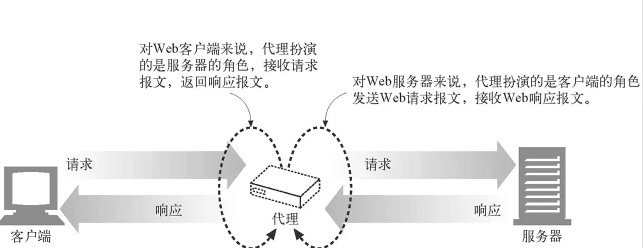httpx HTTP 代理
HTTPX支持通过proxies参数设置 HTTP 代理,该参数将在client初始化或顶级API函数(如HTTPX)上传递。

例
要将所有流量(HTTP 和 HTTPS)路由到位于 http://localhost:8030的代理,请将代理 URL 传递给Client...
with httpx.Client(proxies="http://localhost:8030") as client:
...对于更高级的用例,请传递代理dict(dict为python的字典类型,也可翻译为字典,此处不做翻译)。例如,要将 HTTP 和 HTTPS 请求路由到 2 个不同的代理,分别位于http://localhost:8030 和http://localhost:8031 ,请传递代理 URL 的dict:
proxies = {
"http://": "http://localhost:8030",
"https://": "http://localhost:8031",
}
with httpx.Client(proxies=proxies) as client:
...有关代理路由的详细信息,请参阅本章节的 路由 部分。
补充:
在大多数情况下,https://key的代理URL应该使用http://scheme(这不是拼写错误!)。
这是因为HTTP代理需要启动与代理服务器的连接。虽然您的代理可能支持通过HTTPS执行,但大多数代理仅支持通过HTTP执行。
有关详细信息,请参阅本章节的 转发与隧道。
认证
代理凭据可以作为代理 URL 的userinfo部分传递。例如:
proxies = {
"http://": "http://username:password@localhost:8030",
# ...
}路由
HTTPX提供了细粒度的控制,用于决定哪些请求可以通过代理,哪些不可以通过代理。此过程称为代理路由。
代理字典将URL模式(“代理密钥”)映射到代理URL。HTTPX将请求的URL与代理密钥进行匹配,以决定应该使用哪个代理(如果有的话)。从最特定的代理密钥(例如https://<domain>:<port>)到最不特定的代理密钥(例如https:///)进行匹配。
HTTPX 支持基于scheme、域、端口或这些方案的组合的路由代理。
通配符路由
通过代理路由所有内容...
proxies = {
"all://": "http://localhost:8030",
}方案路由
通过一个代理路由HTTP请求,通过另一个代理路由HTTPS请求...
proxies = {
"http://": "http://localhost:8030",
"https://": "http://localhost:8031",
}域路由
代理域“example.com”上的所有请求,让其他请求通过...
proxies = {
"all://example.com": "http://localhost:8030",
}代理HTTP请求在域“example.com”上,让HTTPS和其他请求通过...
proxies = {
"http://example.com": "http://localhost:8030",
}代理所有请求到“example.com”及其子域,让其他请求通过...
proxies = {
"all://*example.com": "http://localhost:8030",
}将所有请求代理到“example.com”的严格子域,让“example.com”等请求通过...
proxies = {
"all://*.example.com": "http://localhost:8030",
}端口路由
在端口1234上代理HTTPS请求到“example.com”...
proxies = {
"https://example.com:1234": "http://localhost:8030",
}代理端口 1234 上的所有请求...
proxies = {
"all://*:1234": "http://localhost:8030",
}无代理支持
还可以定义不应通过代理路由的请求。
为此,请传递None作为代理URL。例如...
proxies = {
# Route requests through a proxy by default...
"all://": "http://localhost:8031",
# Except those for "example.com".
"all://example.com": None,
}复杂配置示例
您可以组合上述路由功能来构建复杂的代理路由配置。例如。。。
proxies = {
# Route all traffic through a proxy by default...
"all://": "http://localhost:8030",
# But don't use proxies for HTTPS requests to "domain.io"...
"https://domain.io": None,
# And use another proxy for requests to "example.com" and its subdomains...
"all://*example.com": "http://localhost:8031",
# And yet another proxy if HTTP is used,
# and the "internal" subdomain on port 5550 is requested...
"http://internal.example.com:5550": "http://localhost:8032",
}环境变量
HTTP代理也可以通过环境变量进行配置,尽管其细粒度控制较少。
有关详细信息,请参阅有关 HTTP_PROXY,HTTPS_PROXY,ALL_PROXY的文档。
代理机制
注意
本节介绍高级代理概念和功能。
转发与隧道
通常,通过代理发出 HTTP 请求的流程如下:
- 客户端连接到代理(初始连接请求)。
- 代理代表您将数据传输到服务器。
步骤 2 的确切执行方式取决于使用两种代理机制中的哪一种:
- 转发:代理为您发出请求,并发回从服务器获得的响应。
- 隧道:代理代表您与服务器建立 TCP 连接,客户端重用此连接来发送请求并接收响应。这称为 HTTP 隧道。此机制是您可以从 HTTP 代理访问使用 HTTPS 的网站的方式(客户端通过代理提供的 TCP 连接与服务器执行 TLS 握手来“升级”到 HTTPS 的连接)。
代理疑难解答
如果您在设置代理时遇到问题,请参阅我们的疑难解答指南。





更多建议: